page 1
http://threesology.org
Researchers as of 12/2/2019
| Pages in the Language Threes series | |||||
| 1 | 2 | 3 | 4 | A | B |
| C | D | E | F | G | H |
Let's take a look at the basic structure of the ear because we acknowledge the importance of hearing to speech development. This importance is easily recognized by simply observing the attempts of deaf individuals to express themselves vocally.
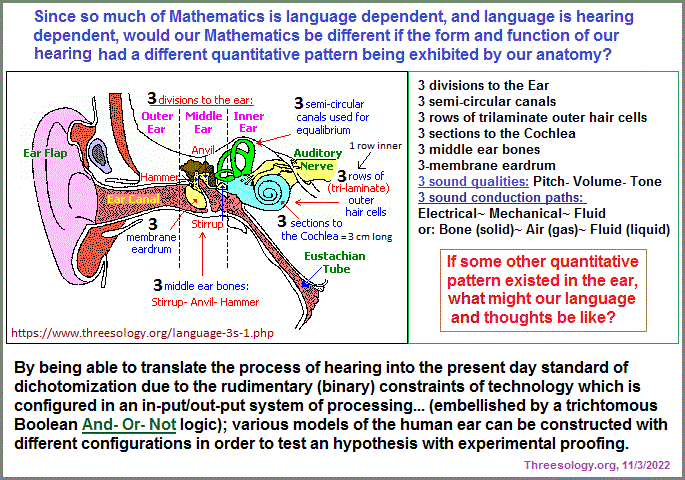 |
| Our 3-patterned Ear structure:
® ®
® Results in... 3-patterned sequences: 3-stage "chunk" infant babbling: Ba- Ba- Ba/ Da- Da- Da/ Na- Na- Na 3 stage word development usage: Single words- Double words- Triple words Trimodal language structure: Subject- Object- Verb 3 sentence types: Simple- Compound- Complex 3 Pronoun types: 1st person- 2nd person- 3rd person 3 Verb moods: Indicative- Imperative- Subjunctive 3 punctuation units: Phrase- Independent clause- Dependent clause 3 Verb inflections: Tense- Mood- Number 3 writing stages: Logography- Syllabography- Alphabetography 3 subordinate clauses: Adjective- Adverb- Noun 3 ending punctuations: Period- Quest. mark- Exclamation 3 gender grammar: Masculine- Feminine- Neuter 3 division structure: Title- Body- Conclusion |
Imagine our language development and usage if our ear was predominantly structured on a different pattern. If we had a 9-patterned ear, would DNA have a 9-patterned coding system? Would there be 9 families of fundamental particles? Would religion have a 3 X 3 (9) godhead instead of a trinity? Can we alter our perception of the "real world" by influencing the development of an auditory (brain) system with a different structure? Can a computer program be set-up to simulate such an alternative development, whereby a more advanced form of logic can be devised and utilized to produce comparable technological advances? Will such advances require the development of a new human species to make better usage of such arrangements?
|
| |
| 3 overall divisions: | Outer ear~ Inner ear~ Middle ear |
| 3 middle ear divisions: | Tympanum~ Epitympanum~ Mastoid antrum |
| 3 eardrum membranes: | Cutaneum~ Collagen fibers~ Mucosm |
| 3 semi-circular canals: | Used for balance (equilibrium) |
| 3 bones: | (ossicular chain) Incus~ Stapes~ Malleus |
| 3 main malleus ligaments: | Anterior~ Lateral~ Superior |
| 3 incus anchorage points: | Malleus~ Stapes~ Bony fossa wall |
| 3 cochlea sections: | (Scala) Vestibuli~ Tympani~ Cochlear duct |
| 3 extrinsic muscles (Auricularis): | Anterior~ Superior~ Posterior |
| 3 sound conduction paths: | Electrical~ Mechanical~ Fluid or: Bone (solid)~ Air (gas)~ Fluid (liquid) |
| 3 nerve stimulation paths: | Mechanical~ Chemical~ Electrical |
| 3 outer hair cell rows (see images below) |
typical in mammals but some sources give 3, 4, or 5 |
| Neurotrophin-3 (NT-3) is synthesized by inner and outer hair cells of the developing organ of Corti. | Brain-derived neurotrophic factor (BDNF) is also synthesized. (Prestin is the motor protein of the outer hair cells.) |
| 3 sound qualities: | Pitch~ Volume (intensity)~ Tone |
| 3 sound wave propagation processes: | Diffraction~ Transmission~ Reflection |
| 3 main forms of ossicular chain fixation: | Fluid~ Mechanical~ Otosclerosis |
| 3 classes of ossicular lever action: | Force arm~ Resistance arm~ Fulcrum |
| 3 acoustic distortion forms: | Frequency~ Phase~ Amplitude |
| 3 basic properties of vibrating bodies: | Inertia~ Elasticity~ Dissipation |
| 3 principal types of deafness: | Conduction~ Nerve~Stimulation |
| 3 types of hearing loss: | Conductive~ Sensorineural~ Mixed |
| 3 (inner ear) organs of balance: | Semicircular canals~ Utricle~ Saccule (collectively called the vestibular organ, which can be referred to as a {3-in-1} ratio.) |
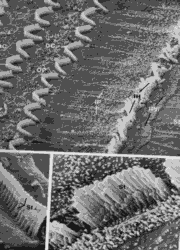
3 to 1 ratio, Stereocilia - organ of corti: These are NOT cilia but more like microvilli. They are remarkable in having precise sizes determined by an as yet unknown mechanism.
The one row of inner hair (IH) cells and the three rows of outer hair (OH) cells are shown. It is also possible to distinguish the surfaces of the inner spiral sulcus cells (SS), the inner phalangeal cells (IPh), the inner pillar (IP) and outer pillar (OP) cells, and the three rows of Deiter's cells (DC), or outer phalangeal cells.
Stereocilia (St) are arranged in a V or W configuration on the outer hair cells. The stereocilia (St) of the outer row on each cell are the longest, and they are uniform in their length. Those of the inner row are the shortest, and those of the middle row are intermediate in length. The remainder of the hair cell surface is smooth and is called a cuticular plate.
Image and information adapted from:
http://web.mit.edu/7.19/www/lecture12/lecture12b.htm
See 3 to 1 references on this page:

Hair cell stereocilia are the site of mechano-transduction, i.e., the translation of the sound vibration into a nervous (bio-electrical) message which the brain can interpret.
The image to the left shows the pattern of arrangement of stereocilia (links) in an adult mammalian cochlear hair cell.
Stereocilia (around a hundred) are generally arranged in three rows of graded lengths. In addition to thin tip links (shown here in red) which are involved in the mechano-transduction process, stereocilia are attached by transverse (lateral) links, both in the same row and from row to row.
Enlargement of the cuticular plate (enhanced in brown) of a (rat cochlea) Outer Hair Cell. The plane of section allows a precise view of the "W" ("3") pattern and a count of 3 rows of stereocilia. Also, the tight coupling with adjacent Deiters' cells is clearly visible (red arrows) this seals the junction between endolymphatic and perilymphatic (spaces of Nuel) compartments. |
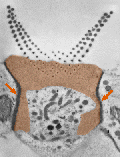 R. Pujol |
3 rows of graded length stereocilia are said to be arranged in a "W" shape. The cuticular plate (internal to the stereocilia) is almost devoid of microvilli, contrasting with the surface of the surrounding support (Deiters') cells. ***Not only can a "W" be seen, which also is the number "3" laid on its backside. |
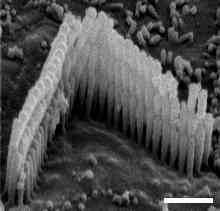 M. Lenoir |
Images and information adapted from:
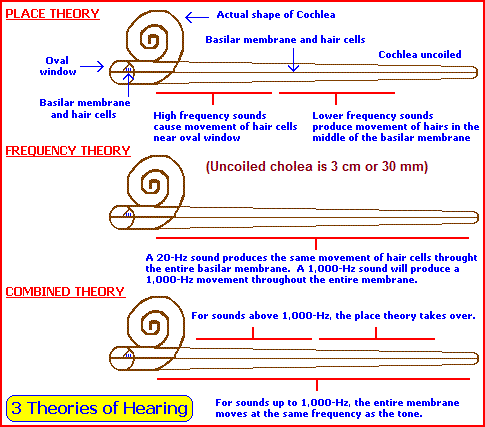
3 turns to the Cochlea, but mismeasured (?) as:
- 2 3/8 turns
- 2 1/4turns
- 2 1/2 turns
- 2 5/8 turns
- 2 3/4 turns
- 2 7/8 turns
- Apparently, 3 turns is the maximum: On the number of turns in human cochleae by Slavomir Biedron, Martin Westhofen, Justus Ilgner
*** Imagine our language development if our ear components exhibited a different predominant pattern: 2, 4, 5, 6, 7, 8, 9, 13, 40, etc...
Three major, at least partially overlapping Ear development processes:
- Morphogenesis transforms the otocyst into a complex three-dimensional structure.
- Cell fate determination turns the uniform columnar epithelial cells of the otocyst into sensory neurons, hair cells and various kinds of supporting cells.
- Proliferation expands the microscopically small sheet of the otic placode cells into a system of several thousand cells that is several millimeters large.
3 senses that the Inner ear has sensory neurons for:
- Hearing.
- Position of head.
- Movement (momentum) of head.
3 inner ear components:
- The cochlea.
- The semi-circular canals.
- The auditory nerve.
3 items typically make their way along the ring-like muscular tube passageway called the throat:
- Air
- Food
- Liquid
3 components of the (speech forming) throat:
Larynx - houses the vocal cords and is crucial to speech and breathing. The larynx also serves as a passageway to both the trachea (windpipe to the lung) and the esophagus (canal to the stomach).
Epiglottis - located above the larynx and works with the larynx and vocal cords to push the food into the esophagus, therefore keeping food from entering the windpipe.
Tonsils and Adenoids - made up of lymph tissue and are located at the back and the sides of the mouth. They protect against infection, but generally have little purpose beyond childhood.
3 Modes of linguistic communication: Oral~ Written~ Signed
3 characteristics of Echoic memory that are reminiscent of children's first word forms:
- Vowels are better represented than consonants.
- Rhythmic aspects of prosody and changes in pitch pattern are better represented than pitch itself.
- Visible phonetic gestures and proprioceptive experience of phonetic form contribute well represented non-auditory traces.
3 kinds of speech acts by John Langshaw Austin (1911-1960):
- Locutions- the uttering of meaningful sentences.
- Illocutions- what one does in saying things, such as stating, promising, urging.
- Perlocutions- what one does by saying things, such as persuading, frightening, embarrassing.
3 sides of language: Expression~ Meaning~ Context
3 years of age is the time when vowels are said to be mastered.
[3 years of age is when Mozart showed signs of remarkable musical talent.]
3 months of age is when Vocal patterns crystallize as birds reach adulthood, meaning that song learning is complete.
By Jill Elish, March 2002
3-part expression used by some parents when confronting a whining/crying/whimpering child:
"Cry me a river~ Build me
a bridge... ~ And get over it."
3 types of tears:
- Basal tears- continuously lubricate our eyeballs.
- Reflex tears- are produced when our eyes become irritated, such as when we chop onions.
- Emotional tears- is the general reference to tears which are produced when we cry as part of our response to a range of psychological triggers. Such crying tears not only have a different cause but also have a different concentration of:
- Chemicals.
- Hormones.
- Proteins to both basal and reflex tears.
By Peter Freeman
t
3 descriptive terms outlining the world of the infant, according to William James: (A) Blooming ~ Buzzin ~ Confusion.
Several researchers have identified 3 different but related types of infant vocalizations though they use varied labeling methods to distinguish them:
Three types of infant vocalizations differentiated by Stark & Nathanson (1973):

- Cry sounds (sounds produced in acute stress such as pain or hunger)
- Discomfort sounds (a lesser degree of discomfort such as when not reaching a toy)
- Vegetative sounds (coughs, burps, sneezes).
3 cry types described by Wolff (1965):
- Basic cry
- Mad/Angry cry
- Pain cry.
3 acoustic types of cry (Truby & Lind, 1965):
- Phonation (basic cry)
- Dysphonation (turbulence)
- Hyperphonation (shift)
When we look at infant babbling, we find there is a 1- 2- 3 maturational development sequence taking place. I am not aware of any studies of babbling on infants whose development would be considered malnourished, retarded, or defective in other ways. Thus, the following examples are characteristic of what is typically referred to as normal development.
There are a variety of sounds that can be heard, but the same 1- 2- 3 pattern is evident:
- Single sounds come 1st, such as ba, na, da, di, ti, etc...
- Double sounds come 2nd, such as ba-ba, ma-ma, da-da, etc...
- Triple sounds come 3rd, such as ba-ba-ba, na-na-na, di-di-di, etc...
Overlapping produces longer strings of "expression" sometimes referred to as "reduplications," such as: ba-ba-ba-ba-ba-ba-ba-ba-ba, etc...
With the onset of the word development stage, we again find a repeat of the same 1- 2- 3 pattern:
- Single words come 1st, such as mommy/ no/ why/ daddy/ more, etc...
- Double words come 2nd, such as mommy home/ no-no/ daddy up, etc...
- Triple words come 3rd, such as doggy fall down/ daddy up-up, etc...
Overlapping of words produces longer phrases and overlapping between words and babbling can produce such "comments" that may be characterized as "babbled words" or "wordy babblings".
As an aside note of correlation, when we muse upon the development of speech long ago amongst ancient groups of people, the usage of the words "KA" (spirit and double of person) and "BA" (representing an idea about the soul) by the ancient Egyptians, along with the word "Ma" -at (Ma'at... goddess of truth and order), share a striking resemblance to babbled words. The (universally) recurring sounds of infants may have been interpreted as having some universal significance that took on adult-like definitions.
The following historical references may be of interest to some readers:
3 rulers are noted for carrying out experiments (by isolating children from all spoken language influences) to determine which language would be spoken first, and hence, identify the first language:
- Egyptian Pharaoh Psammetichus (664-610 B.C.)
- James IV of Scotland (A.D.1473-1513)
- Roman Emperor Fredrick II of Hohenstaufen (A.D.1200's)
3 Types of Languages (Isadore of Seville, 7th Century A.D.):
- All the Oriental nations jam tongue and words together in the throat, like Hebrews and Syrians.
- All the Mediterranean peoples push their enunciation forward to the palate, like the Greeks and the Asians.
- All the Occidentals break their words on the teeth, like the Italians and Spaniards.
Interestingly, some researchers do not recognize a "three-word" stage of expression. Instead, they refer to the stage after a predominant Two-word usage as "Many," though "many" is often referenced as something to the effect of describing an "explosion of language." This One- Two- Many sequence is reminiscent of primitive peoples usage of three words to identify number quantities: In their own language equivalent way, they used:
- The word "one" for the quantity 1.
- The word "two" for the quantity 2.
- And any quantity beyond 2 was considered "Many."
Perhaps it would be more lucrative in our research if we would dispense with the labels of One-word Stage, Two-word Stage, etc., and instead use the labeling system of:
First Word stage- The identification of a predominant usage of single words.
Second Word Stage- The identification of a predominant usage of two words.
Third Word Stage- The identification of a predominant usage by some children to use three words, while others may use four, five, six, etc., word combinations (that some researchers use the generic phrase of 'word explosion' in describing such because different children are exhibiting different quantities/types of words.)
If a researcher's group of infants/children all exhibit a predominant usage of a three-word developmental stage and yet another researcher's group exhibits a predominant usage of four or five words, while still another researcher's group is mixed, where is the collective appreciation of this word stage development if it remains subjectively defined?
By using the above First- Second- Third Word Stage type of compartmentalization of developmental 'mile stones' (or something similar to it), the recognition of different levels/types of "word explosion" will enable us to keep track of developmental trends which may exhibit themselves in this particular arena of vocalized activity. In other words, if there are evolutionary trends in the human species which take place on subtle levels, one of these levels may be through the avenue of verbal development sequences. A cross-cultural, cross-racial, cross-gender, cross- territory, etc., cataloguing may be of value when graphically portrayed.
|
3 considerations of Roman Jakobson about babbling (1940's):
(While this idea of his is considered outdated, the fact remains he used a pattern-of-three format.) 3-patterned babbling stages:
Reduplicative babbling~ Variegated babbling~ Late babbling 3 successive/overlapping stages of infant babbling:
(combinations produce long strings of sounds sometimes referred to as "reduplications") 3 successive/overlapping stages of word development:
(combinations can produce yakety-yak-yak) |
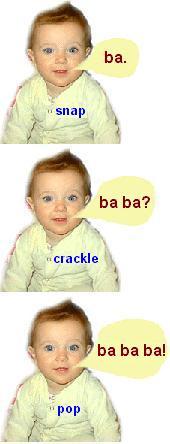 |
| The source for the above babbling baby image comes from this site: by Laura-Ann Petitto Professor Laura-Ann Petitto's home page may be found here: |
Three types of things babies do a lot of with their mouths:
- Babbles (sounds with consonant-vowel repetition, such as "ba, ba, ba").
- "Non-babbles" (sounds without, such as "ahhh").
- "Smiles."
Basic criteria used by Siobhan Holowka, a graduate student at McGill University, Canada, and Dr. Laura-Ann Petitto at Dartmouth College in their research of infant babbling:
The researchers found that the babies' mouths opened more on the right side during babbling, and were symmetrical during non-babbles.
The babies' mouths were asymmetrical toward the left when they smiled, possibly due to the emotion-related activity on the right side of the brain, they surmised.
"Our discovery is the first to demonstrate left hemisphere cerebral specialization for babies' production of language, just like we see in adults," said Dr. Petitto. "This suggests language functions specialise in the brain at a very early age."
30/08/02
3 colloquial references to babbling-like behavior in adults:
- Auctioneers
- Intoxicated individuals
- Individuals experiencing a lack of sleep/sleepiness
The Early Vocalization Analyzer (EVA), is a computer program that automatically analyzes digitized recordings of infant vocalizations. EVA can clinically distinguish between typically developing and non-typically developing infants strictly by acoustic analysis of an infant's syllable structure. The EVA Software is built on the Liu-Stevens Landmark Detection program for adult-speech founded on Stevens' acoustic model of speech production. Central to this theory are "landmarks," points in an utterance around which listeners extract information about the underlying distinctive features. They mark perceptual foci and articulatory targets. The program detects three types of landmarks:
|
|
| |
| T H R E E |
Peter F. MacNeilage and Barbara L. Davis, both psycholinguists at the University of Texas at Austin, say that a handful of basic sound patterns lurks within:
Their findings provide totally independent support for the theory that there was one original language, a mother tongue. MacNeilage and Davis identified three sequences of sound patterns common to babbling and words in general. Each consists of a consonant-vowel combination:
Additional studies directed by MacNeilage and others have identified these three sound sequences in the babbling of infants exposed to native French, Swedish, Japanese, Portuguese, and Quechua, a language spoken in Ecuador. |
| O N E |
A "fourth," more complex sound sequence appeared in infants' first words and across all 10 languages, but not in babbling. Sounds in this three-part sequence start with a lip consonant, followed by a vowel and then a tongue-front consonant (as in "mad"). Other researchers have noted that people have an easier time articulating speech sounds from the front to the back of the mouth, such as "pug," than the reverse, such as "gap." Clearly, in this case, the reference to an additional sound as a "forth" is an indication that researchers (and or those quoting them) often-times misidentify overlapping stages as separate entities that are given specific labels, whereby an inaccurate assessment of the material is acquired. In this instance, I am using the "three-to-one" labeling as a means to highlight that a "four" label can also be a 3-to-1 label, but that neither of these labels need be accurate to the extent that one misaligns a particular event with another grouping, whether or not it is a distinctive pattern-of-three. |
Three essential properties of syllabic vocal babbling are:
- The infants' use of a reduced subset of possible sounds (phonetic units) found in spoken languages.
- Syllabic organization (well-formed consonant-vowel clusters).
- Use without apparent meaning or reference.
Other properties include:
- Reduplication.
- Well-defined age of onset (7 to 10 months), stages of babbling.
- Continuity of phonetic form and syllabic type within an individual child's babbling and first words.
3 most frequently used hand gestures (called "manual babbling") collected during three sessions in which three infants with normal hearing were used as control subjects in a study of deaf infants:
- The closing of a hand shape.
- Movement toward the body.
- An up-and-down movement.
3 hand shapes were observed to be used by the hearing infants in the study and they primarily used 1 syllable type.
***Laura Ann Petitto & Paula F. Marentette3 steps leading to speech are:
- Vocalized self-stimulation.
- Rewarded imitation.
- Association.
--- Psych 200 Unit 2 Module ---
During the first year
- 0-1 month (newborn stage): Reflexive behavior, suck-swallow patterns, non-differentiated crying, vegetative sounds.
- 2-3 months (cooing stage): Definite stop and start to oral movement.
- 4-6 months (babbling): Greater independent control of tongue, prolonged strings of sounds, experiments with sounds, sound play (da, ma, di, du.....).
- 6-10 months (reduplication babbling): Repetitive syllable production, increased lip control, incompletely formed plosives (p,b,t,d) and nasals.
- 11-14 months (first words, usually nouns): elevates tongue tip, complex babbling, intonational patterns.
After the first year
- 18 months: Vocabulary of 20-100 words including nouns and verbs and other parts of speech. Single word sentences.
- 24 months: Vocabulary has grown to 200-300 words, including nouns, verbs and other parts of speech. Two words sentences.
- 36 months: Vocabulary has grown to 900 words including nouns, verbs, pronouns and adjectives. Three word sentences. About 90% of the child's speech is intelligible.
- 48 months: Vocabulary is now at about 1500 words.
C. Chiron, I. Jambaque, R. Nabbout, R. Lounes, A. Syrota, O. Dulac
Brain 1997, 120, 1057-1065
(Summary)
The development of functional brain asymmetry during childhood is confirmed by changes in cerebral blood flow measured at rest using dynamic single photon emission computed tomography. Between 1 and 3 years of age, the blood flow shows a right hemispheric predominance, mainly due to the activity in the posterior associative area. Asymmetry shifts to the left after 3 years. The subsequent time course of changes appear to follow the emergence of functions localized initially on the right, but later on the left hemisphere (i.e. visuospatial and later language abilities). These findings support the hypothesis that, in man, the right hemisphere develops its functions earlier than the left.
Such a view as this inclines us to consider the possibility that early (adult) humans may have had a dominant functioning right hemisphere, and that the attributes of the left hemisphere did not or were not functioning in the manner in which they do today. This notion not only provides support to the idea of a Bicameral-like right hemisphere dominant mentality proposed by the theory of Julian Jaynes, with respect to early humans a few thousand years ago, but that present day humans may experience a similar type of functioning in one or more periods of their life. (Hence, language development may have initially been born in and remained dominant in the right hemisphere and then [for one or more reasons] became a left hemisphere dominant attribute later on.)
Yet, was this type of mental predominance a characteristic of all humans in the past or merely those subjected to a certain type of genetic strain, culture, environment, dietary regime, etc...? H.O.B.
For a short discussion about an historical reference to the development of language in ancient humans:
In the Beginning was the (magic) Word...:
Page Created: Thursday, 13-November-2014... 5:42:19 AM
Maintenance Updates:
Monday, 18-Jan-2016 06:22 AM
Monday, 03-Oct-2016... 12:37 PM
Updated Posting: Monday, 2nd December 2019... 8:03 AM
Herb O. Buckland
herbobuckland@hotmail.com